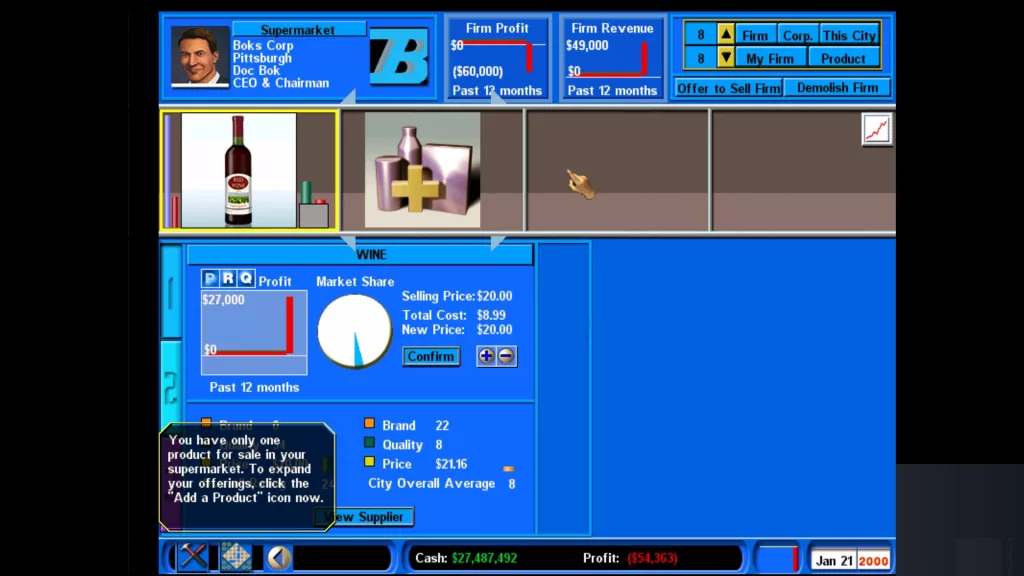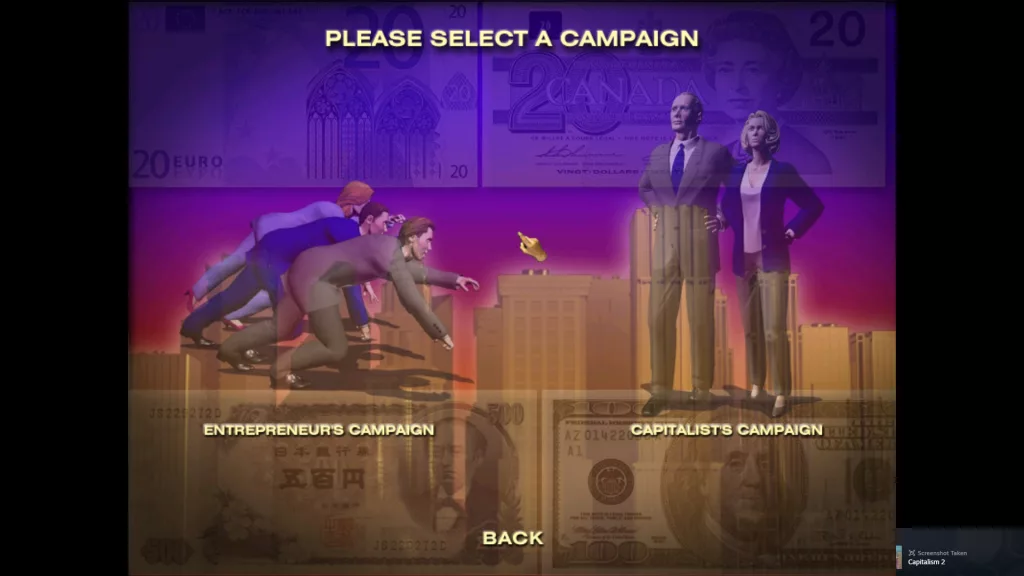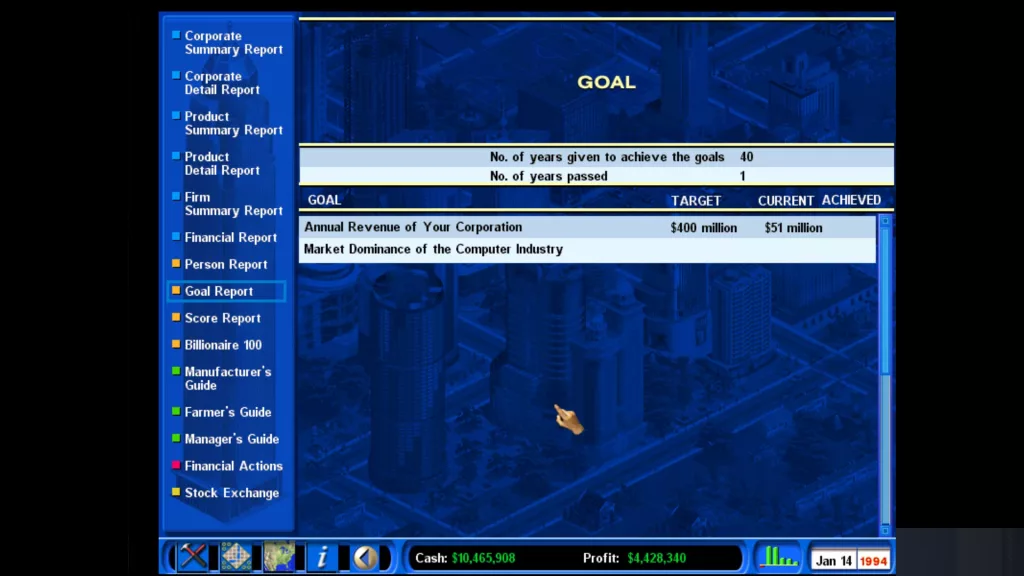This week I spent some time playing a tough game that tries to emulate our economic system. People often ask “if capitalism is so good, why isn’t there a Capitalism 2?” Well, there is, and it’s in my Steam library.
Learning the Ropes
Capitalism 2 is not a simple or easy game. If you’re a fan of Sim City, then this game might feel familiar at first, but it is an entirely new beast. Whereas Sim City involves city planning, bank loans, and financial management, Capitalism is literally its namesake in video game form.
The tutorial is pretty well done, taking you through the basics of the game. You will learn how to create and stock stores, build factories to supply the stores, how to take out and repay bank loans, how to float on the stock market, marketing, how to build farms, how to train staff and hire officers, and finally how to extract raw resources.

For such a long list of features, I was surprised how familiar I had gotten with everything by the end. I was also surprised how much I struggled to get anywhere in the game. This game is brutally hard and will not do you any favours. It reminded me of the first time I played Sim City.
If you stick with it (and read a lot of guides), you will slowly start to figure things out. One thing I learned early on is that if a business is failing, with no chance of recovering, the best thing to do is to shut it down quickly. Profits must go up no matter what, you don’t want any part of your business to be losing money.

There are two campaigns in the game. The first is a series of tutorials. Playing through these will teach you the basics of the game. The second is a series of challenges for you to complete. The first challenge is to dominate the computer market within 40 years.
In my first attempt I set up a full supply line to build a desktop computer. From mining the raw materials, to building the chips, constructing the PCs, right up building a computer store to sell them. No one bought them – there was zero demand for my machines. I tried my best to figure out what I could do to improve things, but to no avail. My money drained away, I took out a loan, and that disappeared as well.
Yeah, I’m not particularly good at this.

Journey to Victory
After a couple more attempts where I watched money drain from the coffers, I was almost ready to give up. I used the power of the internet to look up some guides on how to actually win this mission. The key ingredient I was missing was that I could set prices on products.
This is one criticism I have of the game. The UI can be a bit wonky and unintuitive at times. I can’t say that it’s terrible or badly designed. But the way it is designed shows the game’s age. Once I read that you could set the prices on products, it still took me a while to figure out where I could actually do it. Once I figured it out, I was ready to go.

I started a new game with a plan: I would focus on a single product first, make that profitable, then use the profit to expand my product line. I set up a couple of factories to build desktop PCs (and their components), and made sure they would only sell to my firm. I didn’t want any other companies selling my product. You don’t dominate a market by letting other people in.
I set up a bunch of computer stores in each city, and lowered the price to make them more attractive. This means you make less profit per unit, but you sell more product. In the early stages you want people to buy more.

I watched as my total loss per month slowly decreased, It was working. Once it got to a stage where I knew I wouldn’t lose too much money, I set up a second factory. This one would build palm computers and notebooks. But there was a problem. Both of these products need plastic, and no one was supplying it.
There was an oil resource, however. So I set up an oil rig and a nearby factory to produce plastic. Of course, I made sure that these resources would be available to me and me alone. If I’m to win I need that market dominance.

After ensuring the prices were set at a good point, I also added printers to the mix. Now I had all computer products in production and up for sale. I was dominating the computer market. Money was pouring in. But it still wasn’t enough. You see, a secondary goal was that I needed to be making $400 million a year. I was only making around $50 million.

I could only raise prices so much, and if I built more stores I’d only end up competing with myself. In order to grow I’d have to break into other markets. Then it hit me. There are a lot of buildings on sale. The easiest way to grow would be to buy property.

So buy property I did. It worked at first, but some buildings weren’t making any profit. In fact, I was losing money on them. I tried raising the rents a bit, but to no avail. People just moved out. So I put the buildings up for sale. No takers.
I realised there was only really one option here. I could destroy the building and sell the land. I won’t make my money back, but I’d stop having to pay for building maintenance. So I went on a spree, destroying any buildings that were losing money. After that, I would make sure a building was profitable before I bought it.

While on a property buying spree I saw a rival firm was selling a factory producing electronic components. These are needed for all my products, and I was relying on an external supplier. I also didn’t want my competitors to be supplied with these. So I bought out the factory and made sure they would only supply my firm. This reduced the cost to make all of my products, and ensured I had more control of the market.
Another place I bought was a radio station. Now I owned part of the media. I used the radio station to advertise all of my products. This increases brand recognition, which increases sales, and therefore profit.

After buying as much property as I thought profitable, I waited. The numbers kept going up. Slowly the yearly profit ticked up. Renting out the property increased my profits enough. I reached the $400 million goal. I was still dominating the computer market. I had won the scenario.

Lessons in Capitalism
Playing a game bearing the name Capitalism, I couldn’t help but think about how it applies to the real world. I’ve been reading that the game is used to teach students economics, and I can see why. But I wonder if they use it to teach morality.
When you play GTA and start a shootout with the police it can be extremely fun. Crazy driving, explosions, destruction and chaos. Of course, doing this in real life wouldn’t be as fun. Real people would get hurt, and it would be unlikely you would come out of it alive. Doing it in a video game can be fun because you don’t need to worry about the morality of these actions.

The same can be said of Capitalism. But I think it can be something to think about because the decisions you can make in the game are decisions most people would never make in real life. What if it was real life? How would my actions affect a real world if I did the same.
Well, in my earlier runs I’d be pissing away millions of dollars and ending up destitute. Definitely not something I would want to do in real life. In my more successful runs I ended up doing things that could have moral implications.
Every factory and shop I shut down destroys jobs. Of course, I don’t consider this at all when I play the game. I see it losing too much money, I shut it down and sell the land. I don’t waste time trying to turn it around. It’s easier to just shut it down.

The same can be said of the property I bought. Destroying buildings means people don’t have offices or homes anymore. But it doesn’t matter. The numbers cannot go down, and it’s cheaper to destroy the building than to try and sell it.
Monopolies are supposed to be illegal, but that’s exactly what I did in this game. I made sure that as many resources as possible where only available to my own firm. I needed to control the whole supply chain and be the only one selling my products. Several times other firms offered to buy my research. I refused to sell it. I can’t dominate the market if other firms have it as well.

Then, of course, I started buying the media. I didn’t buy the radio station because I thought it would be profitable. I bought it so I could market my products for cheap. The primary function of that radio station became advertising my brand.
All of this actions were fun to me because I didn’t have to think about consequences. But I can’t help but notice that all of these things happen all the time in the real world. Profit comes first, no matter what. Whether it’s monopolising, controlling supply chains, manipulating the media, or just shutting down non-profitable parts of the business, these things happen all the time.
The numbers must go up. Profit before anything else.
Conclusion
I thought I wasn’t going to like this game. It took me a long time to figure it out. I was ready to say that this game wasn’t for me. But once things started clicking, I got it. This game can be extremely fun when you know what you are doing.
As I said before, the interface can be clunky at times. This, combined with the graphics, really shows the game’s age and my put people off. The music, however, is utterly utterly terrible. Like daggers in your ears. It’s 2-3 awful music loops on repeat, and being an old game doesn’t excuse that. Thankfully you can switch it off, which is one of the first things I did during this game.

Overall though, the game does a great job of simulating Capitalism in a bubble. And when you start to understand the various options you have, you’ll start setting up supply chains and eventually expanding your businesses in no time. There’s a steep learning curve here, but it’s worth climbing to the peak.
There is a sequel, Capitalism Lab, but it’s not available on Steam. It looks like a more modern version of this game, with better hi-res graphics, more features, as well as DLC and mods. I probably won’t try this one soon, but if the dated graphics and interface put people off this game, there’s another option out there.




